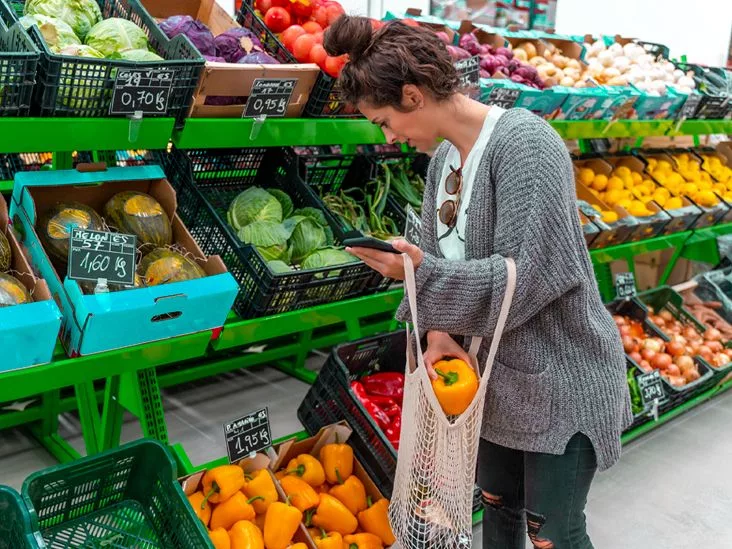Hey there, grocery‑guru in the making! If you’ve ever left the store feeling like you’ve bought a mini‑supermarket’s worth of stuff you’ll never use, you’re not alone. The good news? There’s a simple, science‑backed system that can turn those chaotic trips into calm, budget‑friendly adventures. It’s called the 5‑4‑3‑2‑1 shopping method, and in the next few minutes I’ll walk you through exactly how it works, why it works, and how you can make it your own. Grab a coffee (or a snack, we won’t judge) and let’s dive in.
What Is It?
In a nutshell, the 5‑4‑3‑2‑1 method is a shopping list strategy that tells you to pick:
- Five different vegetables
- Four different fruits
- Three protein sources
- Two sauces or spreads
- One grain, starch, or fun treat
That’s it. No endless scrolling through recipe blogs, no “I’ll just wing it” impulse buys. The numbers act like a friendly guard, keeping your cart balanced and your wallet happy. The concept was popularized by TikTok chef Will Coleman (often seen as @chefwillco), and it’s quickly become one of the most talked‑about viral grocery hacks of 2024.
Core Formula Explained
Let’s break down what each number means and why it matters for both nutrition and budgeting.
| Category | Typical Items | Why It Helps |
|---|---|---|
| 5 Vegetables | Spinach, broccoli, carrots, bell peppers, frozen peas | Fiber, vitamins, low‑calorie bulk – keeps you full without breaking the bank. |
| 4 Fruits | Apples, berries, oranges, bananas (fresh or frozen) | Natural sweetness, antioxidants, easy snack options. |
| 3 Proteins | Chicken breast, eggs, beans, tofu, canned tuna | Satiety, muscle repair, versatile for many meals. |
| 2 Sauces/Spreads | Hummus, peanut butter, salsa, pesto | Add flavor, prevent “bland” fatigue, improve meal satisfaction. |
| 1 Grain/Treat | Brown rice, quinoa, whole‑wheat bread, or a small dark‑chocolate square | Completes macronutrient balance; a treat curbs cravings and keeps you from over‑indulging later. |
Notice how the list leans heavily toward plant‑based foods. That’s on purpose: vegetables and fruits are generally cheaper per calorie and packed with micronutrients. Proteins are the most expensive category, so limiting them to three items forces you to think creatively—canned beans, eggs, or a modest piece of meat can stretch far.
Step‑by‑Step Grocery Guide
Ready to put the method into practice? Follow these four easy steps each week.
1. Pantry & Fridge Audit
Before you even think about the store, open your cabinets and ask yourself: “What’s already here? What’s about to expire?” Write down the staples you’ll need (milk, oil, coffee) – they’re the “basics” outside the 5‑4‑3‑2‑1 framework but essential for any meal.
2. Fill the Numbers
Start at the top of the list. Grab a piece of paper or open a note app and write:
- Five veggies you actually enjoy (or are willing to try).
- Four fruits – one for a snack, two for breakfast, one for a dessert.
- Three proteins – aim for variety (one animal, two plant‑based, for example).
- Two sauces/spreads that pair well with your chosen proteins.
- One grain or treat to round everything out.
If you’re shopping for a family, you can simply double the quantities or adjust the numbers (many families use a “5‑5‑4‑3‑2‑1” version).
3. Shop the Perimeter First
Most experts agree that the healthiest, least processed foods live around the store’s outer ring. According to Chowhound, sticking to the perimeter reduces the temptation to wander down the snack aisles where impulse buys lurk.
4. Stick to the List (But Be Flexible)
When you reach for that 6‑pack of soda, remember your numbers. If a particular fruit is out of season, swap it for a frozen alternative – the method works just as well with frozen produce, which is often cheaper and just as nutritious.
Printable Cheat Sheet
To make life even easier, download a printable “5‑4‑3‑2‑1 Shopping List” template (just search “5‑4‑3‑2‑1 grocery list PDF”). Keep it on the fridge and cross off items as you shop. Seeing the checkmarks will give you a tiny dopamine hit and keep you motivated.
Real‑World Meal Examples
Numbers alone can feel abstract, so let’s paint a picture. Below are two sample weekly plans: one for a single adult, another for a family of four. Feel free to remix the ingredients to fit your taste.
Solo‑Diner Sample
- Vegetables: Spinach, cherry tomatoes, broccoli, carrots, frozen edamame.
- Fruits: Banana, blueberries, an apple, a handful of grapes.
- Proteins: Eggs, canned chickpeas, a small steel‑cut salmon fillet.
- Sauces/Spreads: Hummus, soy‑ginger glaze.
- Grain/Treat: Brown rice, a square of dark chocolate.
Meal ideas: Breakfast – spinach‑egg scramble with a side of berries. Lunch – chickpea‑tomato salad topped with hummus. Dinner – salmon stir‑fry with broccoli, carrots, and soy‑ginger glaze over brown rice. Snack – dark chocolate with a banana.
Family of Four Sample (5‑5‑4‑3‑2‑1)
- Vegetables (5): Mixed greens, bell peppers, zucchini, frozen peas, sweet potatoes.
- Fruits (5): Apples, oranges, strawberries, frozen mango, bananas.
- Proteins (4): Ground turkey, tofu, Greek yogurt, canned black beans.
- Sauces/Spreads (3): Peanut butter, salsa, pesto.
- Grains/Treats (2): Whole‑wheat pasta, wild rice, a small bag of popcorn.
Meal ideas: Breakfast – Greek yogurt with strawberries and banana slices. Lunch – turkey & veggie wraps with pesto. Dinner – tofu‑sweet potato curry served over wild rice, with a side of mixed greens. Snack – apple slices with peanut butter or popcorn.
Notice how each meal uses at least two categories from the list, ensuring you get a balanced profile of carbs, protein, and veggies without extra shopping.
Money Saving Impact
Let’s talk dollars. A structured list like this does more than keep you healthy; it trims waste. A recent study cited by Reader’s Digest found that people who used the 5‑4‑3‑2‑1 method saved an average of 15‑25% on their weekly grocery bills compared to “free‑form” shopping.
Why? Three main reasons:
- Fewer impulse buys. When you have a clear number of items per category, you’re less likely to wander into snack aisles.
- Better use of existing ingredients. By planning around what you already have, you avoid duplicate purchases.
- Less food waste. Buying a set quantity of fresh produce means you’re more likely to use it all before it spoils.
If you normally spend $120 per week, a 20% cut saves you $24 – that’s $96 a month, or over $1,000 a year. Imagine what you could do with that extra cash!
Benefits You’ll Feel
Beyond the numbers on your receipt, you’ll notice a host of personal benefits:
- Balanced nutrition. The method guarantees a variety of vitamins, minerals, fiber, and protein each week – a solid boost for immune health.
- Weight‑management support. High‑fiber veggies and protein keep you fuller longer, naturally curbing overeating.
- Reduced decision fatigue. No more scrolling endless recipe pages; your list tells you exactly what to buy.
- Stress reduction. Knowing you have a ready‑made plan makes the whole grocery experience smoother and more predictable.
In short, you’ll feel lighter, both physically and mentally.
Common Pitfalls To Avoid
Even the best system can trip up if you’re not careful. Here are a few red flags and how to dodge them:
Rigidity
Don’t treat the numbers as a prison. If you need an extra grain for a big batch of soup, add it – just keep the overall balance in mind. A flexible version for active families is the “6‑5‑4‑3‑2‑1” adaptation, which simply adds one extra item to each category.
Ignoring Pantry Staples
Oil, spices, milk, and coffee are the glue that holds meals together. Keep a separate “basics” list so you don’t forget them, but remember they’re outside the 5‑4‑3‑2‑1 count.
Seasonal Gaps
When a fruit is out of season, swap it for a frozen counterpart. Frozen produce retains most nutrients and often costs less, making it a perfect fit for the method.
Over‑Buying “Treats”
A treat is meant to be a small indulgence, not a ticket to a candy aisle binge. Pick something you truly enjoy – a single dark‑chocolate square, a fancy cheese stick, or a handful of nuts – and stick to that portion.
Tools & Resources
Technology can make the method even smoother. Here are a few tools that integrate nicely with the 5‑4‑3‑2‑1 system:
- AnyList or Google Keep. Create a reusable template with the five headings and check items off as you shop.
- Fetch Rewards. While you’re ticking boxes, earn points on eligible purchases (see Fetch for details).
- Printable PDF. Search for “5‑4‑3‑2‑1 grocery list PDF” and print one to hang on your fridge.
Using a dedicated app or printable keeps the process visual, which many people find motivating.
Wrapping Up Thoughts
There you have it – a friendly, down‑to‑earth guide to mastering the 5‑4‑3‑2‑1 shopping method. By giving yourself a simple numeric framework, you’ll shop smarter, eat healthier, and keep more money in your pocket. The best part? It’s adaptable. Whether you’re feeding one busy professional or a bustling family, you can tweak the numbers to suit your lifestyle without losing the core benefits.
So next time you’re about to step into the grocery store, grab your phone, open your list, and remember: five vegetables, four fruits, three proteins, two sauces, and one grain or treat. Feel free to share your own variations in the comments – I love hearing how you make this method your own. Happy shopping, and may your cart be ever balanced!


















Leave a Reply
You must be logged in to post a comment.